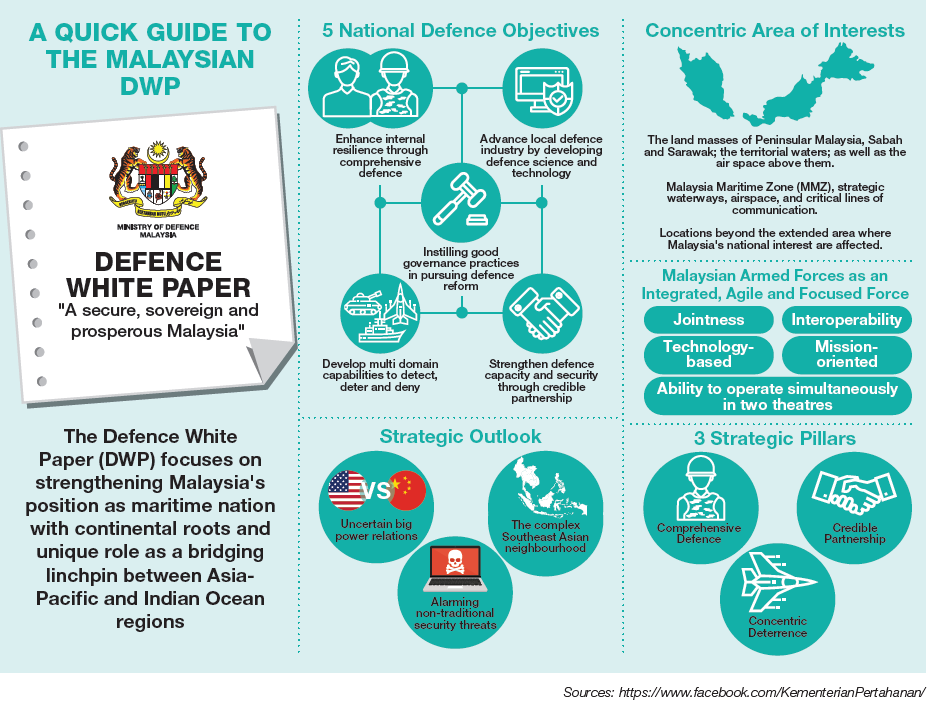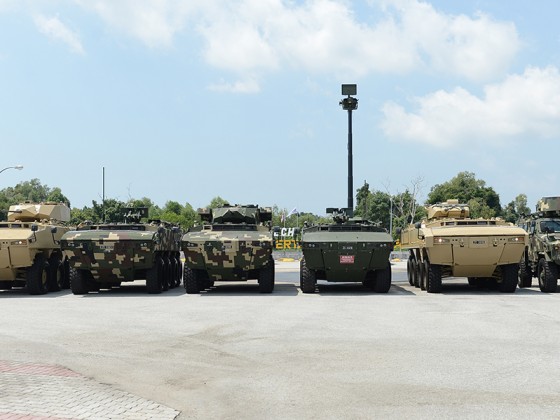by | Sahipulhijaiman bin Sulaiman, Deputy Undersecretary, Policy and Strategic Planning Division, Ministry of Defence
Sahipulhijaiman bin Sulaiman is currently the Deputy Undersecretary, Policy and Strategic Planning
Division, Ministry of Defence (MINDEF) and the lead officer for the development of the recent Defence
White Paper. He was in the private sector for six years before joining the government in 2002. His
earlier postings including the Ministry of Transport for eight years before posted to MINDEF in 2013.
He obtained his Master Degree in Strategic and Defence Studies from Universiti Malaya in 2014 and
has produced a dissertation paper on the role of the Royal Malaysian Navy in encountering Somali
Pirates at the Horn of Africa. He was born in 1972 and currently residing in Kuala Lumpur.

About a year ago on 2nd December 2019, the Malaysian Parliament passed the first Defence White Paper (DWP) to address the issue of national defence and set the way forward for the next ten years until 2030.
“This defensive-postured force of the future will be integrated, agile and focused, as well as able to respond to all threats that Malaysia may have to face. This initiative will be further enhanced through robust participation of the Government together with the rakyat in ensuring the nation’s security, sovereignty and prosperity” as outlined by former Minister of Defence, YB Tuan Haji Mohamad bin Sabu.
Not coincidentally, the DWP’s timeframe has been aligned with the 12th and 13th Malaysia Plans and has been designed in such a way to facilitate defence and budget planning to ensure its successful implementation. The DWP also seeks the support and commitment from both the government and rakyat to invest in defence capability and capacity development in order to overcome the current and future security challenges, which, undoubtedly are becoming more complex and multifaceted. Under these circumstances, the DWP was developed based on evidence, inclusivity and transparency to get the buy-in from various stakeholders.
Now, how is this DWP different from previous defence policies? For one, the DWP offers a different strategy, one that is more holistic and covers all aspects of military power, domestic support and foreign relations. This approach involves rallying all layers of our government and society in dealing with issues related to national defence.
The DWP describes the future defence capability requirements based on national interests, and why it needs be protected. In a nutshell, it gives clear guidance pertaining to policies and military strategies as well as other vital aspects that need to prioritised for the next ten years. Understandably, the DWP is a crucial set of guidelines that can be utilised by the local defence and defence related industry players when it comes to determining which areas that need to be focused on to meet our military needs. This marks an exciting opportunity not only for existing defence industry players, but also to new key industry players that are interested to venture into defence or defence related industry.
DWP and the Makings of a Smart Army
The DWP also dedicates a specific chapter to discuss opportunities and challenges within the areas of defence science, technology and industry. It zooms in on the importance of investing on research and development for defence, and how improvisation and implementation are necessary to finetune the procurement process.
It also advocates for the transformation of the local defence industry which is arguably in great need of change. This means changing how business is done traditionally, which may depend heavily on government contracts and eliminating unsavoury practices that squeeze taxpayers’ money in the name of profit optimisation). Instead, the DWP is hoped to be the catalyst towards a more liberated and diversified business by exploring other commercial sectors and penetrating the global market. This makes perfect sense as the amount of untapped opportunities for our local defence industry to venture into the defence market can be leveraged.
Consider this: many commercial technologies that are part of our daily lives originated from the defence industry. Likewise, many commercial products available on the shelf have been adopted for military use after careful studies have been made. Now if we look at the list of defence capability requirements in the DWP, many of the items in the list can be sourced from commercially available products. For example, in the area of ISR (Intelligence, Surveillance and Reconnaissance), many of the products (think: sensors and drones) are available in the market and can be utilized or upgraded to meet military requirements. Similarly, looking at the defence industry, many products like 3-tonne trucks can be modified for the commercial market. The question is, can our local defence industry think big outside the box and venture out of their comfort zones? Can they truly look to the East and provide products or services to other consumers outside the defence industry, like what Japanese companies have done. Many of us are familiar with brands like Mitsubishi and Fujitsu, and how these brands are synonymous with vehicles and IT related products within the consumer market, but did you know that they also build fighter jets and provide surveillance systems for the Japan Self Defence Force (JSDF)?
Deconstructing the Opportunities Outlined by the DWP
As the military marches on towards embracing the advancement of technology aligned with the fourth industrial revolution (4IR), the door leading to a wealth of opportunities for the local defence and defence related industry is thrown wide open. Although Malaysia may not be at par yet with other developed nations, key industry players should still endeavour to build partnerships with foreign companies to gain insight and innovations in beefing up our defence industry capability. This can be made possible through technology transfer, or acquiring and tweaking the technology itself to suit our needs as well as requirements.
And let’s not forget that our local graduates in fields related to the defence industry most certainly have the capability to produce defence solutions locally, given enough trust and funds channelled into R&D while tapping into in-house manufacturing opportunities. The changes in warfare from conventional into hybrid that combine physical and virtual realm also provide new areas for business opportunities. This is one of the many emphasis outlined by the DWP focusing on “technological-based advancements” as part of the characteristic of our future military force.
Needless to say, we need to move forward by embracing the modern doctrine of war, and realise that putting more troops out on the field is no longer feasible especially since soldiers can be substituted with technological advancement in the course of creating a more cost-effective and efficient military force. Meanwhile, the current military personnel should be retrained and their roles realigned to suit the evolving ecosystem.
DWP and the Defence Industry: Threats and Challenges
The DWP can be accessed online by just about anyone, which means we can expect foreign governments and defence industry players to express interest towards contributing to the Malaysian defence capability development. This translates to our local defence and defence related industry possibly facing healthy competition from international companies when it comes to bidding on government defence projects.
Many would view this as a challenge, taking into account the possible lack of ample experience from our industry players compared to international entities. Strong industry players such as those from France and the US have had great proven track records that can be hard to beat. However, all is not lost: there is definitely room for improvement as we seek to learn from countries like China and Turkey where their companies have recently gained more shares in the defence and security market. It is a known fact that many of their products are developed based on reverse engineering and joint ventures with other experienced companies. More encouragingly, they were able to produce similar or more superior products at a lower cost. As such, our local defence industry should not be intimidated but instead must step up their capability and capacity to be able to compete and offer better products or services at a more competitive price. All this may sound preposterous, but it is highly possible. What we need is the right mindset to invest and procure the right resources. Our local defence and defence related industries should take this opportunity to seek foreign partners who have had years of experience and technological know-how in manufacturing military grade products that are proven and accepted worldwide.
Driving Solid Collaborations Towards Smart Defence Industry Growth
This is another reason why the defence industry is identified as an important focus area in current and future defence cooperation as prescribed in the DWP. Acknowledging that defence diplomacy is another form of deterrence in defending the country, the DWP discusses the current bilateral and multilateral relations with Malaysian partner countries and indicates our interests in future engagement with other potential partners.
The defence industry is a proponent of credible partnership between countries as it can certainly benefit both sides under the arrangement of defence cooperation. Through strong defence collaborations, local companies tap into international think-tanks either through government-to-government (G-to-G) or business-to-business (B-to-B) engagements during meetings, conferences or exhibitions. The Policy and Strategic Planning Division (Bahagian Dasar dan Perancangan Strategik, BDPS) and the Defence Industry Division (Bahagian Industri Pertahanan, BIP) under the Ministry of Defence can be a solid bridge to link Malaysia and other countries when comes to defence cooperation. Local companies are encouraged to communicate with these two divisions to get advice and prospects in other countries.
The defence industry has also been incorporated as part of a strategy to increase our defence capability in the 12th Malaysia Plan. It shows that the government has acknowledged the importance of the defence industry in contributing towards a more resilient and vibrant Malaysian economy. This is parallel with the DWP which calls upon the local defence industry to not only to assist the government in achieving self-reliance, reducing dependency on foreign countries, but to also re-invigorate the current economic landscape as it can potentially give high returns and provide many job opportunities to Malaysians.
Next Steps Towards a More Robust Malaysian Defence Industry
In conclusion, there is indeed a brighter future for the local defence and defence related industries as outlined by the DWP. Currently, the government is working on a National Defence Industry Policy to pave the way forward for all stakeholders in the industry. This is a very positive development that indicates the government’s commitment in improving the local defence industry.
Now is the time for Malaysian industry players to change their mindset, to be more diverse and more competitive in overcoming current challenges as well as reach out to grab untapped opportunities. New companies should also consider looking at the defence or defence related industry as another area of business to venture into and invest due to their great potential in the future. Many countries in the Asia Pacific and the Indian Ocean regions are increasing their defence spending shows how vast opportunities can look like for defence or defence related industries. Recent budget announcements by Japan, Republic of Korea and Indonesia among others are clear evidence that governments will continue to invest in their national defence as security concerns are gaining attention among policy makers. Malaysia is not far behind, as political masters and the rakyat are becoming more aware of defence issues with the release of the DWP. The local defence and defence related industry must tap this expanding market and seize opportunities to grow beyond their familiar playing field.









